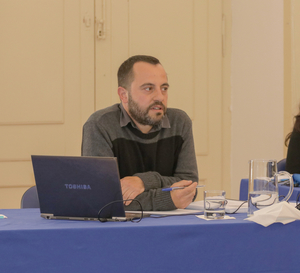
Doutoramento em Gestão Interdisciplinar da Paisagem
Transition pathways: Assessing land management strategies in Mediterranean areas
Luís Filipe Barroso

Orientação: Maria Teresa Amado Pinto Correia
Co-orientação: Gianluca Brunori & Yves Michelin
Agriculture in the European Union is at the center of debate about worldwide concerns surrounding food security, climate change and energy, although is also required to remain competitive in a global market period and at the same time keeping and ensuring higher standards of food production and satisfying the new demands for public goods and services. As a result, European rural landscapes are facing several changes, which might reveal that an ongoing transition process is taking place. The transition theory suggest that transitions might be taking place, both at farm and at local landscape level, leading to an increase differentiation of the rural areas (Wilson 2007; Marsden 2003). Nevertheless these transition processes remain to be understood in Southern Mediterranean landscapes which maintain a distinctive landscape character increasingly valued by society due to their potential of providing public goods such as environmental quality, leisure, nature conservation and cultural identity. Further, new ways of managing these areas arise where a multiplicity of other land managers rather than conventional farmers are identified. Therefore, different holdings, profiles, management decisions, behaviours and attitudes emerge. Based on these questions and assumptions described above, this thesis intends to focus on rural areas in transition, in Mediterranean Europe, (Southern Portugal) to analyze the different farm management strategies in place. The aim was to track and describe the distinct typologies of land managers and to assess their adaptation capacity to changes taking place. The aim is to identify typologies of transition pathways and the factors, internal and external to the farm, that support the innovation required for the multifunctional transition. The thesis also aims to find evidence of the coexistence of different strategies at local level, and to identify and characterize the spatial distribution pattern of areas concerned with these different farming strategies. The aim was to test a group of indicators to understand the transition processes based on the surveys, as well as submitting data to a probabilistic multivariate statistical analysis in order to identify the groups with similar management strategies. From this comparison, a several typologies were will be produced along with a spatial distribution of farms, considering also the relation to the broader landscape characteristics. The resulted data was analysed, which lead to a better understanding of the most influent factors on the different land managers types identified. Therefore we provide insights about which land managers are better adapted to the changes happening. Which land managers are linked to certain kinds of holdings. Which are the drivers that encourage or prevent innovation and changes in the holdings. Results reveal the heterogeneity of Mediterranean agriculture and land ownership as well as the importance of understanding the typologies of land managers and their expectations about the landscape they use. This knowledge can support better-oriented policies and management decision.
Agriculture in the European Union is at the center of debate about worldwide concerns surrounding food security, climate change and energy, although is also required to remain competitive in a global market period and at the same time keeping and ensuring higher standards of food production and satisfying the new demands for public goods and services. As a result, European rural landscapes are facing several changes, which might reveal that an ongoing transition process is taking place. The transition theory suggest that transitions might be taking place, both at farm and at local landscape level, leading to an increase differentiation of the rural areas (Wilson 2007; Marsden 2003). Nevertheless these transition processes remain to be understood in Southern Mediterranean landscapes which maintain a distinctive landscape character increasingly valued by society due to their potential of providing public goods such as environmental quality, leisure, nature conservation and cultural identity. Further, new ways of managing these areas arise where a multiplicity of other land managers rather than conventional farmers are identified. Therefore, different holdings, profiles, management decisions, behaviours and attitudes emerge. Based on these questions and assumptions described above, this thesis intends to focus on rural areas in transition, in Mediterranean Europe, (Southern Portugal) to analyze the different farm management strategies in place. The aim was to track and describe the distinct typologies of land managers and to assess their adaptation capacity to changes taking place. The aim is to identify typologies of transition pathways and the factors, internal and external to the farm, that support the innovation required for the multifunctional transition. The thesis also aims to find evidence of the coexistence of different strategies at local level, and to identify and characterize the spatial distribution pattern of areas concerned with these different farming strategies. The aim was to test a group of indicators to understand the transition processes based on the surveys, as well as submitting data to a probabilistic multivariate statistical analysis in order to identify the groups with similar management strategies. From this comparison, a several typologies were will be produced along with a spatial distribution of farms, considering also the relation to the broader landscape characteristics. The resulted data was analysed, which lead to a better understanding of the most influent factors on the different land managers types identified. Therefore we provide insights about which land managers are better adapted to the changes happening. Which land managers are linked to certain kinds of holdings. Which are the drivers that encourage or prevent innovation and changes in the holdings. Results reveal the heterogeneity of Mediterranean agriculture and land ownership as well as the importance of understanding the typologies of land managers and their expectations about the landscape they use. This knowledge can support better-oriented policies and management decision.
Keywords: Land manager type, multivariate analysis, attitudes, behaviors, Multifunctional transitions, typologies, Innovative land managers




